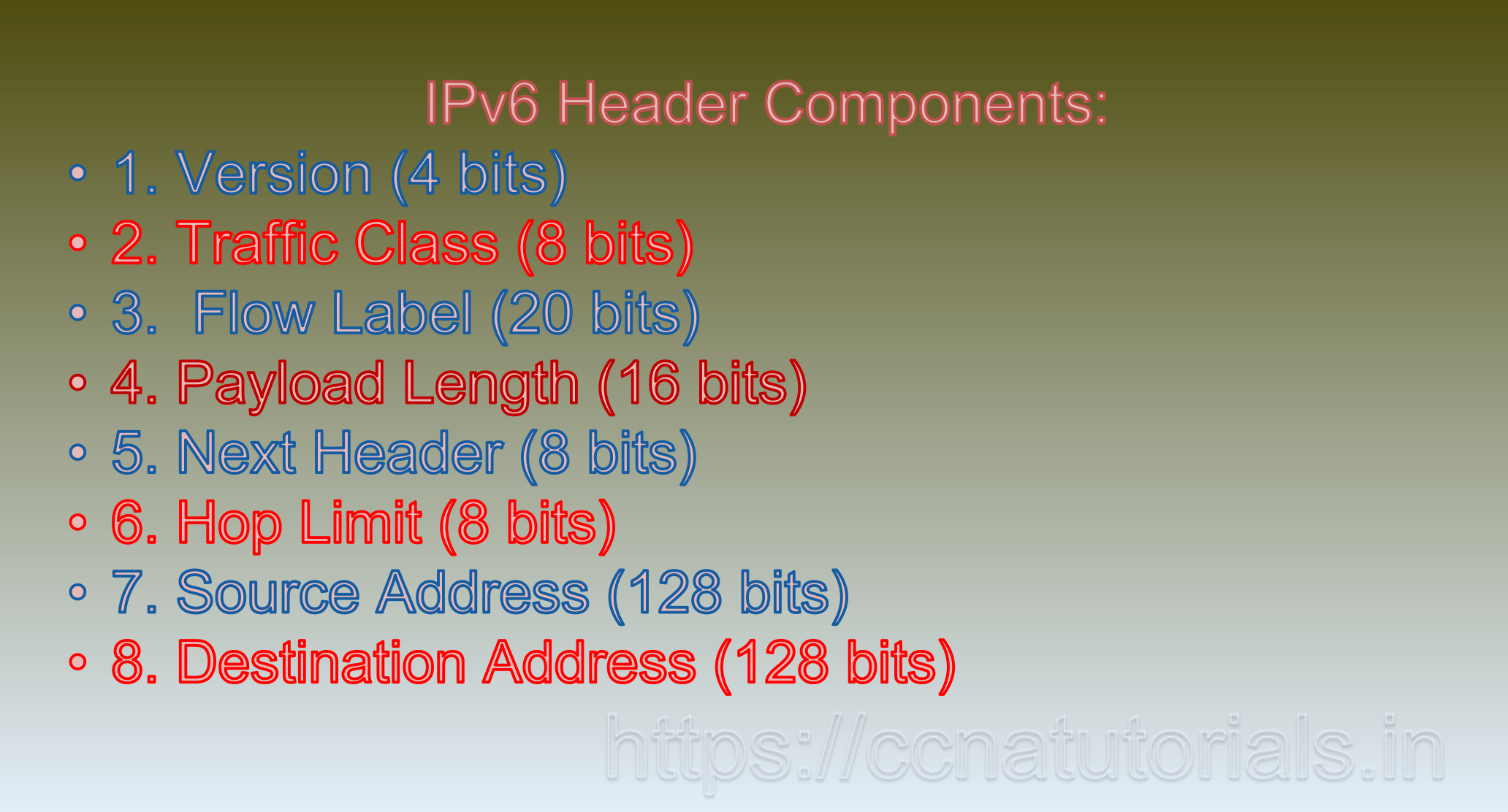Contents of this article
In this article, I describe IPv6 Header Format of data packets flowing in a network. The IPv6 header format lies at the heart of modern networking, defining the structure and content of data packets that traverse the vast expanse of the Internet. As a successor to the aging IPv4 protocol, IPv6 brings forth a streamlined and efficient header format that not only accommodates the expanded address space but also introduces enhancements to support evolving networking requirements. In this exploration, we delve into the intricacies of the IPv6 header format, dissecting its components and shedding light on how it facilitates seamless data communication in the digital age.
The Evolutionary Leap:
The IPv6 header format embodies a significant departure from its predecessor, IPv4. The need for this transformation was driven by the limitations of IPv4’s 32-bit address space, which was increasingly exhausted in the face of escalating demand for IP addresses. IPv6’s 128-bit address space not only overcomes this scarcity but also enables more efficient routing, simplified configuration, and improved security.
IPv6 Header Components:
The IPv6 header comprises a carefully designed set of fields, each serving a specific purpose in facilitating packet forwarding, routing, and network operation. Let’s delve into the key components of the IPv6 header format:
1. Version (4 bits):
This field identifies the IP protocol version, with a fixed value of 6 for IPv6.
2. Traffic Class (8 bits):
The Traffic Class field, analogous to the IPv4 Type of Service (ToS) field, prioritizes packets based on their importance or desired quality of service (QoS).
3. Flow Label (20 bits):
Introduced to support flow-based packet handling, the Flow Label field assists routers in identifying packets belonging to the same flow. It enables efficient handling of real-time and multimedia traffic.
4. Payload Length (16 bits):
This field specifies the length of the IPv6 packet’s payload, which includes both the extension headers and the actual data. Unlike IPv4, where the header length is fixed, IPv6 can accommodate variable-length extension headers.
5. Next Header (8 bits):
The Next Header field indicates the type of the next header in the packet, which could be either another extension header or the upper-layer protocol header (e.g., TCP, UDP).
6. Hop Limit (8 bits):
Serving a role similar to IPv4’s Time to Live (TTL) field, the Hop Limit field decrements with each hop the packet makes, preventing packets from endlessly circulating the network.
7. Source Address (128 bits):
This field holds the source IPv6 address, identifying the originator of the packet.
8. Destination Address (128 bits):
The Destination Address field contains the target IPv6 address, determining where the packet should ultimately arrive.
Extension Headers:
The IPv6 header format introduces the concept of extension headers, which can be inserted between the main IPv6 header and the upper-layer protocol header. These headers provide flexibility and extensibility, enabling the addition of specialized functionalities without altering the core IPv6 header.
Common extension headers include:
1. Hop-by-Hop Options Header:
This header carries options that must be examined by every router along the packet’s path. It is used for specialized processing, such as quality-of-service (QoS) marking.
2. Routing Header:
The Routing Header specifies a list of intermediate destinations that the packet must visit. This can be used for source routing or to guide packets through specific segments of the network.
3. Fragment Header:
When a packet is too large for a network link, the Fragment Header is used to split it into smaller fragments that can be reassembled at the destination.
4. Authentication Header (AH) and Encapsulating Security Payload (ESP):
These headers provide security services, including authentication, integrity, and encryption, to ensure the confidentiality and integrity of data.
Simplified Header Processing:
The IPv6 header format is designed with efficiency in mind. By eliminating fields that were seldom used in IPv4 and placing critical information at the beginning of the header, IPv6 reduces the complexity of packet processing for routers and network devices. This simplification accelerates routing decisions, enhances forwarding performance, and contributes to improved network efficiency.
Benefits and Future Prospects:
The IPv6 header format brings several notable benefits to the networking landscape:
1. Streamlined Processing:
The simplified header format reduces processing overhead for routers, resulting in faster packet forwarding and reduced latency.
2. Enhanced Security:
Extension headers like AH and ESP provide robust security mechanisms, ensuring the integrity, authenticity, and confidentiality of transmitted data.
3. Efficient Flow Handling:
The Flow Label field facilitates improved handling of real-time and multimedia traffic, contributing to optimal Quality of Service (QoS) support.
4. Addressing Flexibility:
The 128-bit source and destination addresses accommodate an extraordinary number of unique addresses, enabling the continued expansion of the Internet of Things (IoT) and new addressing paradigms.
5. Extensibility:
The introduction of extension headers allows for the integration of new features and functionalities without necessitating changes to the core IPv6 header.
As the digital landscape continues to evolve, the IPv6 header format stands as a testament to the adaptability and innovation of networking protocols. Its design principles, coupled with the extensibility introduced by extension headers, ensure that IPv6 remains a foundational element of the Internet’s architecture, empowering the ever-growing web of interconnected devices and services. With its efficient routing, robust security, and forward-looking design, IPv6 addresses the demands of a globally connected world and paves the way for a future of seamless, secure, and efficient data communication.

Explanation of IPv6 Header Format in another way
The IPv6 header format is a crucial component of the IPv6 protocol, outlining the structure of data packets that traverse networks. This header contains essential information for routing, forwarding, and handling the packet as it moves through the network. Let’s break down the IPv6 header format and illustrate it with examples.
IPv6 Header Format:
The IPv6 header consists of several fields, each serving a specific purpose in guiding the packet through the network. Here’s a breakdown of the IPv6 header format:
+—————-+——————-+——————-+——————-+
| Version (4 bits) | Traffic Class (8 bits) | Flow Label (20 bits) |
+—————-+——————-+——————-+——————-+
| Payload Length (16 bits) | Next Header (8 bits) | Hop Limit (8 bits) |
+—————-+——————-+——————-+——————-+
| Source Address (128 bits) |
+——————-+——————-+——————-+——————-+
| Destination Address (128 bits) |
+——————-+——————-+——————-+——————-+
| Extension Headers (if present) |
+——————-+——————-+——————-+——————-+
| Data (Upper-layer Protocol and Payload) |
+——————-+——————-+——————-+——————-+
Let’s explore each field with examples:
1. Version (4 bits):
This field indicates the IP protocol version being used. For IPv6, the value is `0110`.
2. Traffic Class (8 bits):
Similar to the IPv4 Type of Service (ToS) field, it prioritizes packets based on desired quality of service. Example: `0x10` for high-priority traffic.
3. Flow Label (20 bits):
The Flow Label field assists routers in identifying packets belonging to the same flow. Example: `0x12345`.
4. Payload Length (16 bits):
This field specifies the length of the packet’s payload, excluding the header. Example: If the payload is 400 bytes, the value would be `0x0190`.
5. Next Header (8 bits):
This field identifies the type of the next header following the IPv6 header. Example: `0x06` for TCP.
6. Hop Limit (8 bits):
Similar to the TTL in IPv4, it limits the number of hops a packet can take. Example: `64`.
7. Source Address (128 bits):
This field contains the sender’s IPv6 address. Example: `2001:db8:1234:5678::1`.
8. Destination Address (128 bits):
This field contains the recipient’s IPv6 address. Example: `2001:db8:abcd:ef00::2`.
Extension Headers:
Extension headers provide flexibility and allow the insertion of various optional headers between the main IPv6 header and the upper-layer protocol header. Common extension headers include:
– Hop-by-Hop Options Header: Contains options that must be examined by every router along the packet’s path.
– Routing Header: Specifies a list of intermediate destinations the packet must visit.
– Fragment Header: Used to fragment large packets for transmission.
– Authentication Header (AH) and Encapsulating Security Payload (ESP): Provide security services like authentication and encryption.
Example Packet:
Let’s put it all together with an example packet:
Suppose we have a simple IPv6 packet carrying TCP data. The source address is `2001:db8:abcd::1`, and the destination address is `2001:db8:efgh::2`. We’ll omit extension headers for simplicity.
+—————-+——————-+——————-+——————-+
| 0110 | 00100000 | 0010011010100010 | 0000000001001001 |
+—————-+——————-+——————-+——————-+
| 00000001 | 00000110 | 0010000000000100 | 0000000001000000 |
+—————-+——————-+——————-+——————-+
| 2001:db8:abcd::1 (128 bits) |
+——————-+——————-+——————-+——————-+
| 2001:db8:efgh::2 (128 bits) |
+——————-+——————-+——————-+——————-+
| TCP Header and Payload (Upper-layer Protocol and Data) |
+——————-+——————-+——————-+——————-+
In this example, the IPv6 header format is depicted with its various fields filled in, and it encapsulates a TCP packet. The source and destination addresses are provided as well, along with their corresponding IPv6 addresses.
Conclusion for IPv6 Header Format in IPv6 networking
The IPv6 header format’s simplicity, enhanced capabilities, and support for extension headers make it a powerful foundation for modern networking. Its adaptability to various networking scenarios and integration with advanced features contribute to the robustness and efficiency of the IPv6 protocol, shaping the way data packets are routed and forwarded across today’s interconnected networks.






